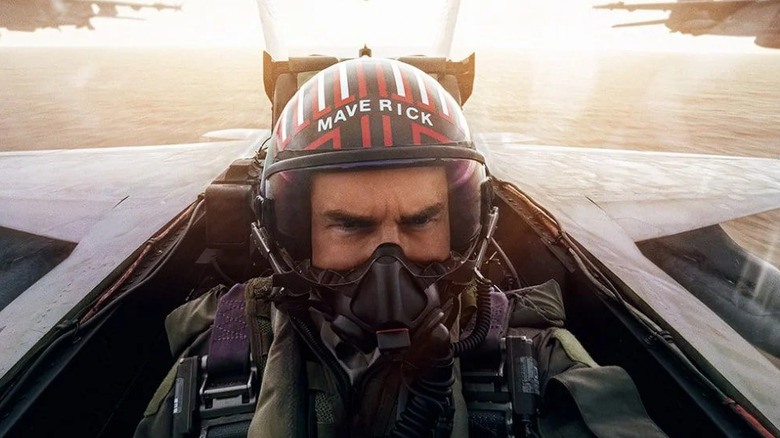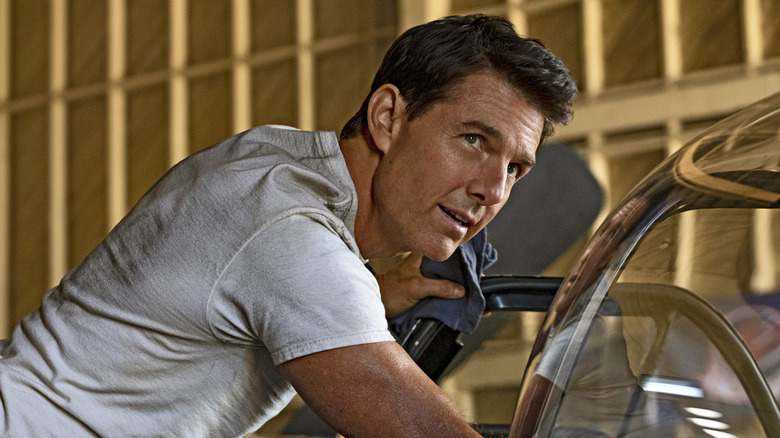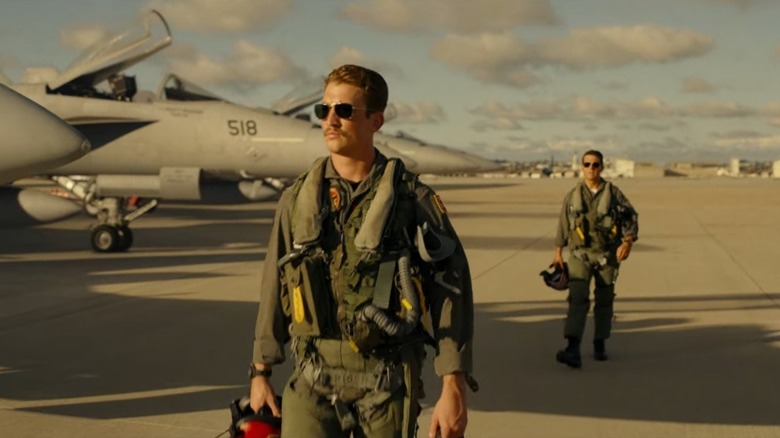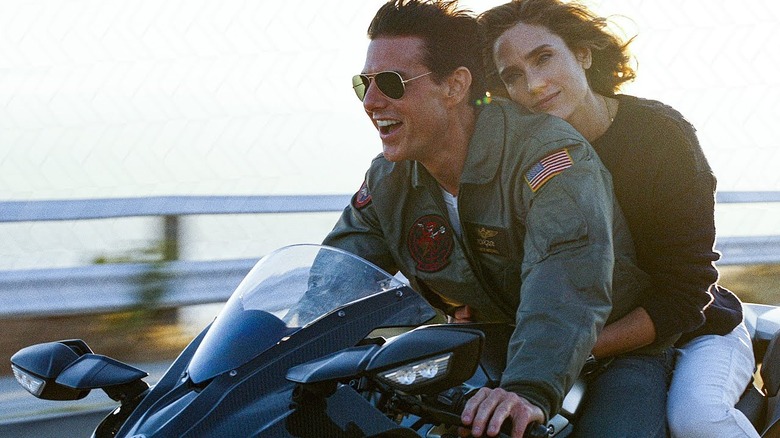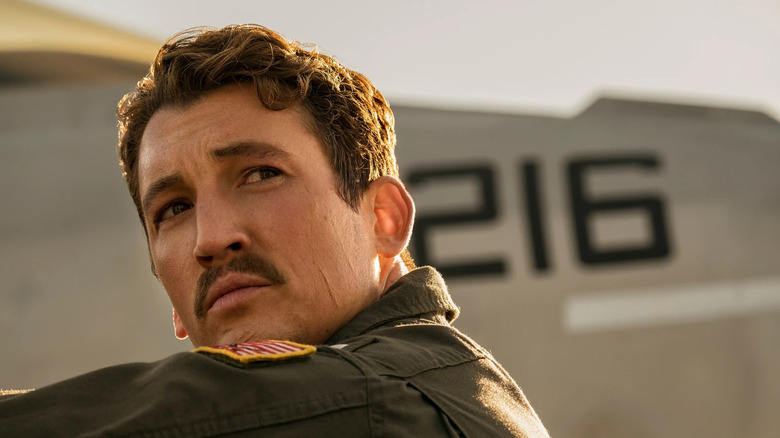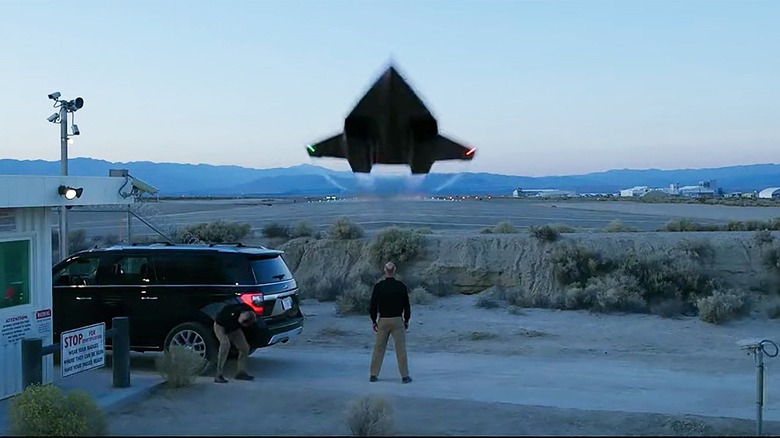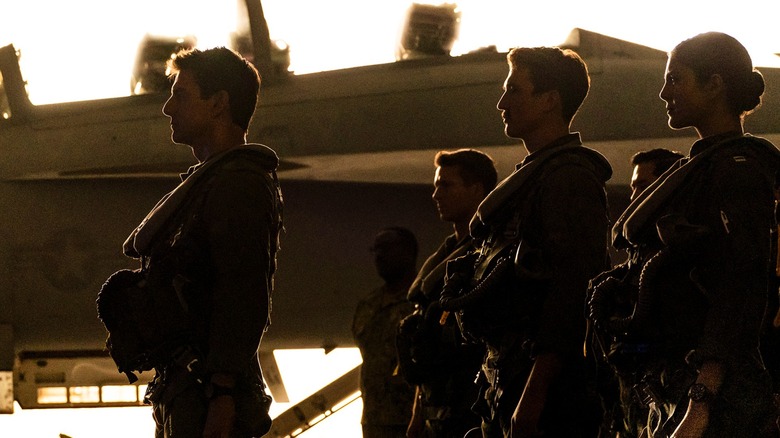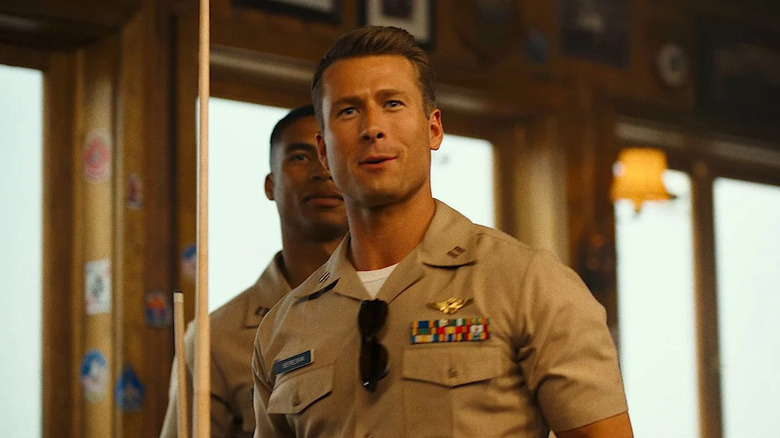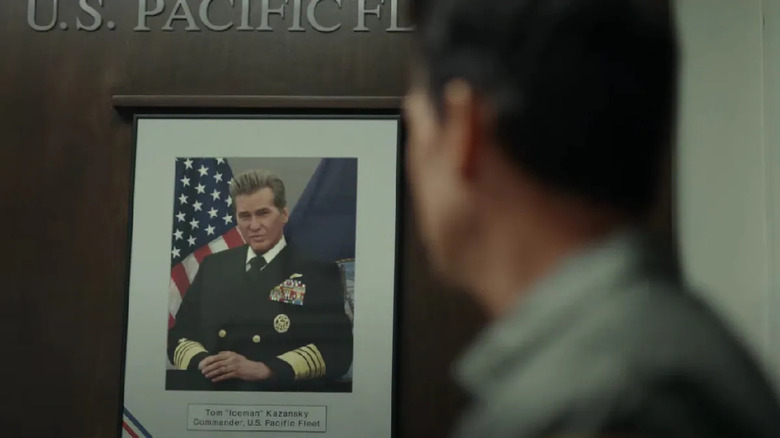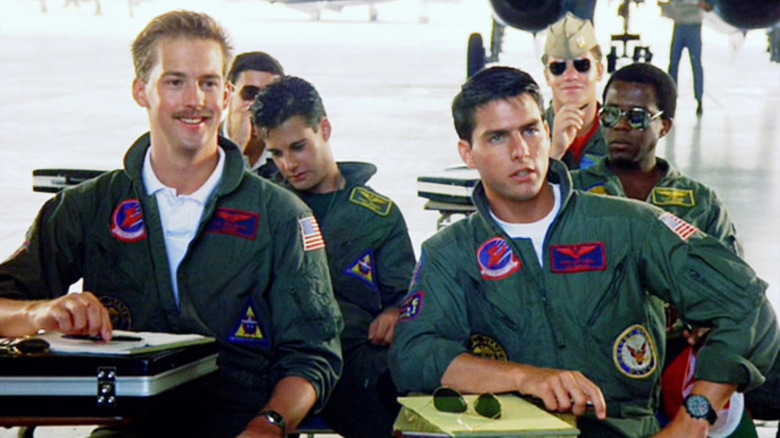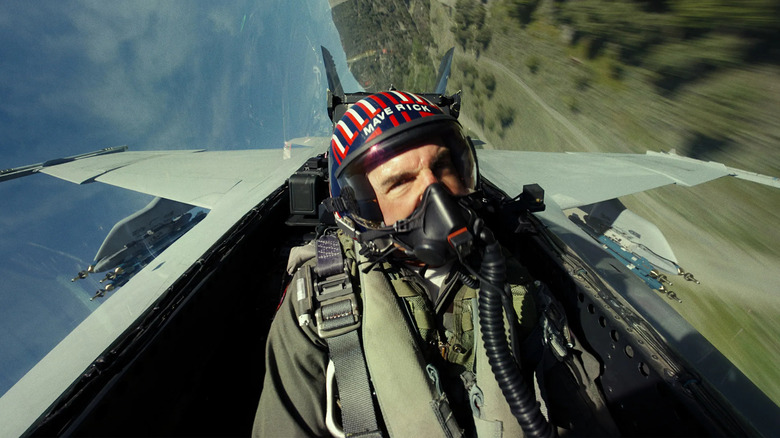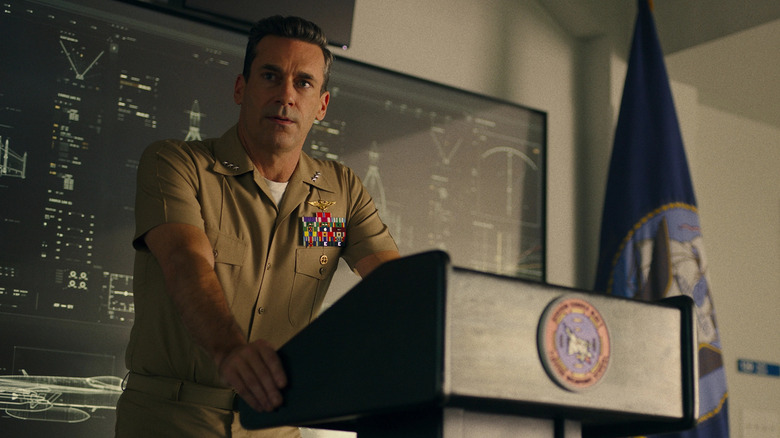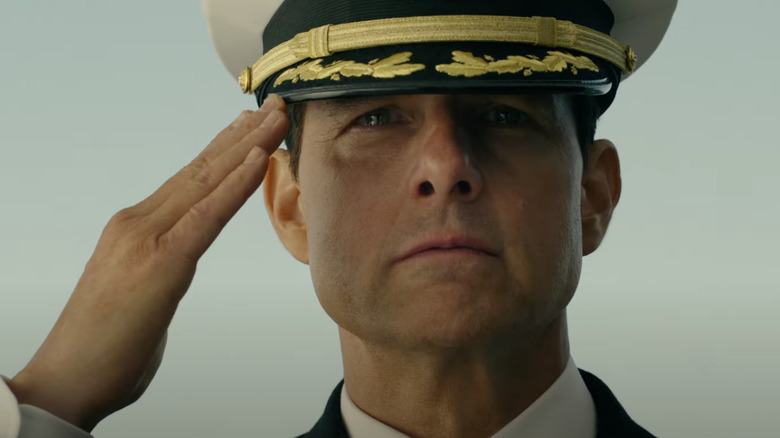The Ending Of Top Gun: Maverick Explained
After 35 years of waiting, "Top Gun: Maverick" arrived in the summer movie season of 2022. It launched a new story in the saga of Pete "Maverick" Mitchell (Tom Cruise), the hotshot pilot from the original film who's older but not necessarily wiser, still flying planes as far and as fast as he can. An intriguing blend of old and new, "Top Gun: Maverick" is an attempt to recapture the spirit of the original film while also pushing things further, granting closure to Maverick's story while also breaking new ground with epic flight sequences and a story that passes the torch to a new generation.
The film is a straightforward action adventure film, but it also packs in quite a bit of character work and multifaceted plotting. All of that makes for an exciting film that builds to a complex and satisfying ending, one that means different things to many different characters. So, now that you've taken the ride that is "Top Gun: Maverick," let's unpack the whole ending, from Maverick's own journey to the story of Top Gun itself.
And of course, there are SPOILERS AHEAD for the whole film.
Maverick's journey
At several points during "Top Gun: Maverick," we see Maverick almost lose his wings within the Navy forever. It happens at the beginning of the film when he takes an unauthorized test flight, it happens later when he dares to challenge the restrictions of training, and it happens once more when he finally loses his cover within the Navy with the death of friend and former rival, Iceman (Val Kilmer) — who used his status as admiral to protect Maverick.
This is, of course, the ultimate threat one can level at him, as Maverick emphasizes repeatedly that flying is all he knows how to really do well. He spends the whole movie fighting off the idea that he might be out of the cockpit for good, until he's finally proven himself enough to fly as team leader on the mission at the heart of the film. A few hiccups aside, the mission is successful, and Maverick returns home a hero. After that, the film doesn't really tell us exactly what he's going to do next in terms of his career, but we do see him back in his hangar, working on that old P-51 Mustang he's apparently been fixing up for a long time. It's not definitive proof that he's moved on, but watching Maverick take to the skies in the Mustang, rather than an F-18 or another experimental aircraft for the Navy, suggests that he's begun making peace with the idea that he doesn't have to be a naval aviator forever. By finishing the Mustang, he's seemingly finished that chapter in his story.
Maverick and Rooster
One of the key tensions in the film is the relationship between Maverick and Bradley "Rooster" Bradshaw (Miles Teller), the son of Maverick's former navigator Goose (Anthony Edwards), who was killed in action in the original "Top Gun" film. In the wake of Goose's death, Maverick did his best to step in and be a kind of surrogate father for his best friend's son, but at some point that instinct went a little too far. The film reveals that Rooster is still angry over his father's early death, and also angry that Maverick pulled his application paperwork from the Naval Academy, setting his whole career back by several years because Maverick himself didn't think Rooster was ready.
The film presents a journey for both men not just as individuals, but as teammates, as Maverick has to learn to stop handling Rooster with kid gloves, and Rooster has to learn to stop holding a grudge. It takes a long time for them to figure this out, but when they're shot down together behind enemy lines, they manage to build what looks like a lasting bond. Rooster's presence in Maverick's home at the very end of the film, and his pictures on Maverick's wall, suggests that he'll be sticking around with his surrogate dad for quite some time to come.
Maverick and Penny
Penny Benjamin (Jennifer Connelly) is a character referenced in the original "Top Gun" as one of Maverick's exes, indicating that these two have a decades-long history that Penny is eager to put behind her. Throughout the film, even as Maverick is back in her life, she repeatedly warns him from making further advances. Eventually, of course, it's clear that something else is happening, and when they get back together, Maverick makes a promise: He won't leave again.
He eventually keeps that promise by returning from his near-death experience on the mission, only to find that she's departed on a sailing trip, presumably to ward off the idea that he wouldn't be coming back. At the end of the film, it's Penny who returns to Maverick, not the other way around, suggesting that they've finally managed to meet each other where they both are. Maverick's willingness to take her up in the plane he's restored with his own two hands further cements the bond they've built. They're both ready to settle down — and settle down with each other.
Rooster's journey
When he's first introduced in "Top Gun: Maverick," Rooster is very much a foil for Maverick, a painful reminder of what he's lost and the ways in which he's failed in his life. But Rooster doesn't just exist to serve Maverick's character. He's got struggles of his own to go through.
In the training flights for the mission at hand, we see Rooster emerge as the most cautious of the pilots in the field, the one who'd rather take his time and deal with known issues than fly into the unknown or rush to action. This prompts Maverick to constantly tell him to focus more on doing than on thinking. It's hard for Rooster to make that shift, even as he sees his fellow pilots doing it around him. Only when the mission is on the line, and it's clear that he has no other choice but to act quickly and decisively, does he emerge from his shell to become the kind of pilot Maverick also knew he could be.
By the end of the film, Rooster has emerged as a more self-assured version of the pilot he was at the beginning of the film. He's learned to let go of his fears, and he's also learned to let go of some old pain, leaving him better for it.
The future of test pilots
In the beginning of "Top Gun: Maverick," Maverick's been working as a test pilot for the Navy for years, spending his days pushing the limits of new aircraft as far as they can go. But as we soon learn, the program where he's made his home is about to be scrapped in favor of unmanned aircraft, something he's determined to prove he can stop.
Maverick fails to prove himself better than an unmanned program, crashing the experimental jet and leaving an Admiral very angry with him. He's shipped off to Top Gun for one last mission, but he proves himself there, establishing the ongoing value of pilots in cockpits even in an age when drones can do a lot of the work. We see Maverick's value to his mission in the film, but one thing that remains unaddressed is how the test pilot programs will be affected by his performance. Will he be able to advocate to higher-ups in the Navy for continued use of pilots like him? Can he save the jobs of the people he used to work with, or is his ability to move on from his old gig a sign that everyone else has to move on too?
The rest of the team
Though Maverick and Rooster make up the core emotional narrative in "Top Gun: Maverick," they aren't the only pilots in the game. Maverick works with several of the world's best fighter pilots throughout the execution of the mission, and they all seem to have something to contribute. Phoenix (Monica Barbaro) and her weapons systems officer Bob (Lewis Pullman) bring a steadfastness and cool-headedness to the team, while Payback (Jay Ellis) and his own WSO Fanboy (Danny Ramirez) bring a certain swagger to the team. In the final mission, they each have their role to play, and by the end, they've all made it through.
It's clear based on the stakes of the mission that each of these pilots will have their lives forever changed by being part of it. They'll get promotions and commendations, they'll take their valuable experience on to other missions, and they might even prove to be the next generation of Top Gun heroes and instructors, who'll teach the next class of great pilots how to fly. Maverick's legacy is much more than his own achievements. He's created a whole new group of Mavericks to fly behind him.
Hangman's growth
In the original "Top Gun" film, Maverick faced off against Iceman, a cocky, immensely self-confident pilot who antagonized his competitors and did his best to get an edge over everyone, no matter what. In "Top Gun: Maverick," that role falls to Hangman (Glen Powell), a hotshot young pilot who, when the film begins, is the only active aviator of his generation to have a confirmed kill in combat. He brings a tremendous ego to the training flights for the mission, often showing an unwillingness to work as part of a team, and as a result he's left on the backup crew when the mission finally flies out near the end of the film.
But Hangman is not content to stay on the sidelines. He still has a part to play, and he finally shows it at the very end of the battle, when he saves both Maverick and Rooster from an enemy jet after their own hijacked F-14 runs out of ammunition. He does it with his usual swagger, but also with a demonstration that he knows when to be a hotshot, and when to be a teammate. Hangman's got a long way to go, but by the end of the film, it's clear that he's willing to change if it means being a part of something greater than himself.
Iceman's legacy
We don't see a lot of Iceman in "Top Gun: Maverick," but what the film shows delivers some interesting context about his place in the film's universe and in Maverick's story. He went on to become an admiral and the commander of the Pacific Fleet, and yet he's still in Maverick's phone simply as "Ice," implying the closeness they reached at the end of the original film has continued in the intervening years. When Maverick visits him at his home and finds Iceman dying, the two share an embrace and an intimate conversation, suggesting that neither has forgotten all that they've been through together.
When Iceman dies later in the film, it's a wake up call to Maverick that he needs to prove he still has what it takes to be a leader and a teacher, but it also feels like something larger. Iceman and Maverick represent two different paths taken out of that original film, one who became a leader and the other who stayed in the pilot's seat, determined to control the only thing he was ever sure he was good at. Iceman's legacy within the film is a belief in the sustained power of human pilots, but also a belief in the sustained power of learning to teach and help others, something he finally taught Maverick in the end.
Goose's legacy
Maverick's best friend and former navigator, Goose, is long dead by the time "Top Gun: Maverick" begins, but his spirit hangs over the whole film. We see it in the photos Maverick keeps in his hangar, in the way his son Rooster plays piano just like he once did, and in many other mementos and memories conjured up throughout the film.
But Goose's legacy is about more than just memories. In the original "Top Gun," he was always the happy warrior, a guy sure of his abilities but also sure that there were more important things than the cockpit. He was a family man, a loving man, and an example to his friends and peers. Over the course of "Top Gun: Maverick," we watch as both Maverick and Rooster come to be more like Goose in their own ways. They both soften, learn to bend a little bit rather than break, and come to find that things beyond the mission are worth fighting for. It's a powerful legacy for a guy both men lost more than 30 years ago.
Geopolitical implications
The mission at the heart of "Top Gun: Maverick" is a complex, dangerous combat flight to destroy a another nation's new facility for enriching uranium, before said uranium can be deposited at the site. It's a tricky ride full of surface-to-air missiles and enemy planes, so the Top Gun crew has to do their best to prepare for every facet of it. The mission is, of course, ultimately successful, the facility is destroyed, and several enemy planes are shot down in the process.
This of course raises the question: What are the geopolitical implications of this operation? It obviously happened under deep secrecy, to the point that the enemy had no inkling it was coming until a series of missile strikes launched to slow their air response. The film doesn't tell us which country is responsible for the facility, or how delicate U.S. relations are with them outside of this particular issue. It's possible the pilots at the heart of the mission may have many more combat flights in their future, or it's possible it'll all just go away because no one wants to admit to building the uranium facility. Either way, it's fascinating to think about.
The future of Top Gun
In the original "Top Gun" film, it was understood that these pilots and the institution which trained them would go on seemingly forever, with no challenge to their necessity or their power within the U.S. military complex. By the time of "Top Gun: Maverick," that's at least somewhat in question. Maverick's test pilot work is being undercut by drone programs, and while that doesn't necessarily apply to Top Gun itself, he also spends much of the film butting heads with Cyclone (Jon Hamm), Top Gun's apparent commander, who has little respect for Maverick himself and believes that his style of flying and teaching is about to go the way of the dinosaurs.
By the end of the film, of course, Cyclone grudgingly grows to respect Maverick's unorthodox methods and his abilities as both a pilot and as an instructor. He teaches by getting up there and doing things no one else dares to do, and by ultimately proving that his way of doing things is still valuable to the Navy. It's hard to imagine a world in which this doesn't have an impact on the immediate future of Top Gun, its students, and its instructors. Given how little we know about Maverick's own work with the Navy after the events of the film, though, it's hard to pin down exactly how that impact will land.
Learning to let go
In the middle of "Top Gun: Maverick," when Maverick goes to Iceman's house to talk through his difficulties with the mission and with training the pilots he's been assigned, Maverick tells Iceman that being a pilot is not "what I am," but "who I am." He emphasizes that he's not a teacher, that he doesn't know how to pass along what he's learned, and that he can't handle the burden of what it might mean if he fails. Iceman, communicating mostly through a computer because of his illness, responds by typing "It's time to let go."
This means many things in the wider context of the film. It means it's time for Maverick to let go of the guilt he feels for losing Goose and for what he did to Rooster earlier in his career. It means it's time for him to let go of the life he used to have, and it means it's time for him to let go of the fear that he's going to inadvertently cause more loss of both lives and careers. Iceman re-emphasizes this point more than once in the conversation, leaving Maverick with the conclusion that he simply has to learn how.
By the end of the film, Maverick has seemingly let all of it go. He's no longer afraid of losing who he is, or what he does, or of letting down the people around. He's able to take his own advice, stop thinking about it, and just do it, and in the end that might be the most important thematic through line of "Top Gun: Maverick."
